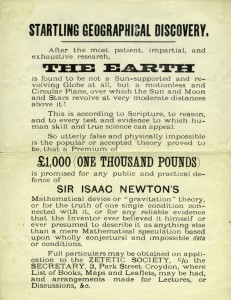 Startling Geographic Discovery. After the most patient, impartial, and exhaustive research, the Earth is found to be not a Sun-supported and revolving Globe at all . . . So utterly false and physically impossible is the popular or accepted theory proved to be, that a Premium of £1,000 (One Thousand Pounds) is promised for any public and practical defence of Sir Isaac Newton’s Mathematical Device of “gravitation” theory . . . Croydon: The Zetetic Society, [ca. 1880?].
Startling Geographic Discovery. After the most patient, impartial, and exhaustive research, the Earth is found to be not a Sun-supported and revolving Globe at all . . . So utterly false and physically impossible is the popular or accepted theory proved to be, that a Premium of £1,000 (One Thousand Pounds) is promised for any public and practical defence of Sir Isaac Newton’s Mathematical Device of “gravitation” theory . . . Croydon: The Zetetic Society, [ca. 1880?].
Thus trumpeted forth this challenge from Croydon, a small broadside that stands as an ephemeral puzzle piece in the pseudo-scientific career of a similarly puzzling monomaniac, John Hampden (1819-1891), long considered perhaps the foremost public face of the 19th century British flat-earth movement.
Hampden had a peculiar genius for becoming embroiled in controversy, a genius well suited for a Zetetic evangelist in search of publicity, and he had long waged a war of pamphlets, journals, and various challenges from his Croydon location. His best known entanglement came after the naturalist Alfred Russell Wallace accepted a challenge (given variously as £100, £500, or £1000) to disprove the Bedford Level experiment, a test originally carried out along the Old Bedford River in Norfolk by the Flat Earth Society president Samuel Birley Rowbotham, who purported to show that the mast of a boat rowing away from him remained visible for six miles–thus suggesting to the rational mind that the earth is not curved.
Hampden had offered a wager (similar to the one issued via this broadside) that Rowbotham’s results could be duplicated, and thus prove that the earth is flat. Wallace–who was also a trained surveyor and at that period somewhat hard up for cash–perhaps foolishly took Hampden up on the offer.
Wallace of course won the wager but made a lasting enemy of Hampden, who persecuted Wallace over the next two decades. As Wallace recounts in his memoir My life: a record of events and opinions (1905),
One day about this time we happened to have several friends with us, and as we were at luncheon, I was called to see a gentleman at the door. I went, and there was Hampden! I was so taken aback that my only idea was to get rid of him as soon as possible, but I afterwards much regretted that I did not ask him in, give him luncheon, and introduce him as the man who devoted his life to converting the world into the belief that the earth was flat. We should at least have had some amusement; and to let him say what he had to say to a lot of intelligent people might have done him good. But such ‘happy thoughts’ come too late. He had come really to see where I lived, and as our cottage and garden at Godalming, though quite small, were very pretty, he was able to say afterwards that I (the thief, etc.) was living in luxury, while he, the martyr to true science, was in poverty. . . . And this man was educated at Oxford University! Seldom has so much boldness of assertion and force of invective been combined with such gross ignorance. . . . The two law suits, the four prosecutions for libel, the payments and costs of the settlement, amounted to considerably more than the £500 I received from Hampden [the balance of the stakes Hampden withheld, alleging fraud], besides which I bore all the costs of the week’s experiments, and between fifteen and twenty years of continued persecution—a tolerably severe punishment for what I did not at the time recognize as an ethical lapse.
That Hampden, entangled as he was in various libel suits and campaigns of harassment against Wallace, would come forward with another monetary challenge suggests the depths of his conviction.
Hampden published a number of pamphlets in support of his ideas, including the intriguing Outbreak of Rabies at the Greenwich Observatory: The Professors Frantic–Astronomy Doomed (Croydon: John Hampden, 1890), a work mentioned in the bibliography of Christine Garwood’s Flat Earth: The History of an Infamous Idea (2007) but otherwise unlocated in the British Library catalog, on Copac, or on OCLC. (One might choose to interpret its scarcity as emblematic of the soundness of Hampden’s ideas, though certainly he best represents a certain strain of thought deserving at least some study.)
This broadside has since been reserved for an institution, but the description remains:
[Hampden, John]. Startling Geographic Discovery. After the most patient, impartial, and exhaustive research, the Earth is found to be not a Sun-supported and revolving Globe at all . . . So utterly false and physically impossible is the popular or accepted theory proved to be, that a Premium of £1,000 (One Thousand Pounds) is promised for any public and practical defence of Sir Isaac Newton’s Mathematical Device of “gravitation” theory . . . Croydon: The Zetetic Society, [ca. 1880?]. First edition. Broadside, approx. 11.25 x 8.5 inches. A trifle chipped along an old fold; some dust-soiling; in very good condition.
